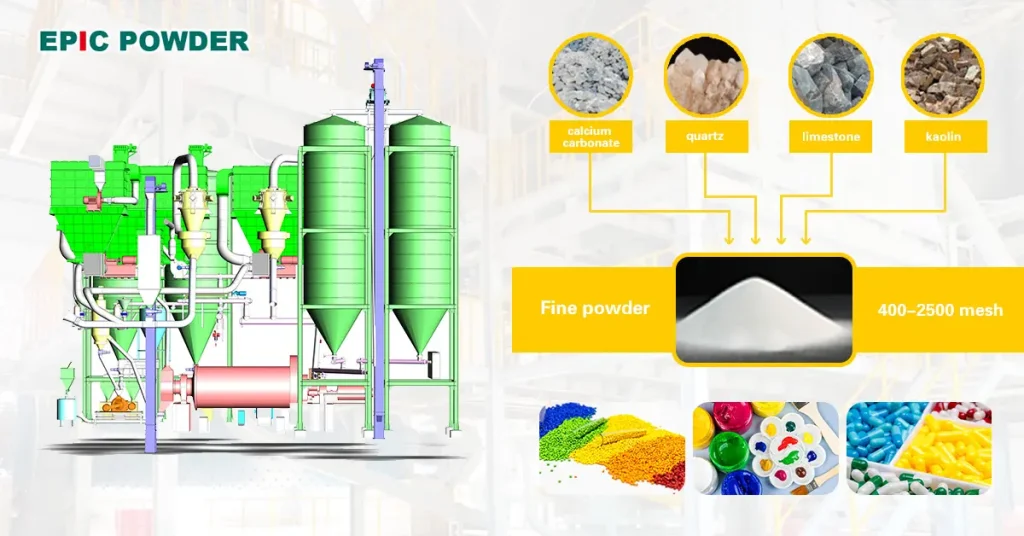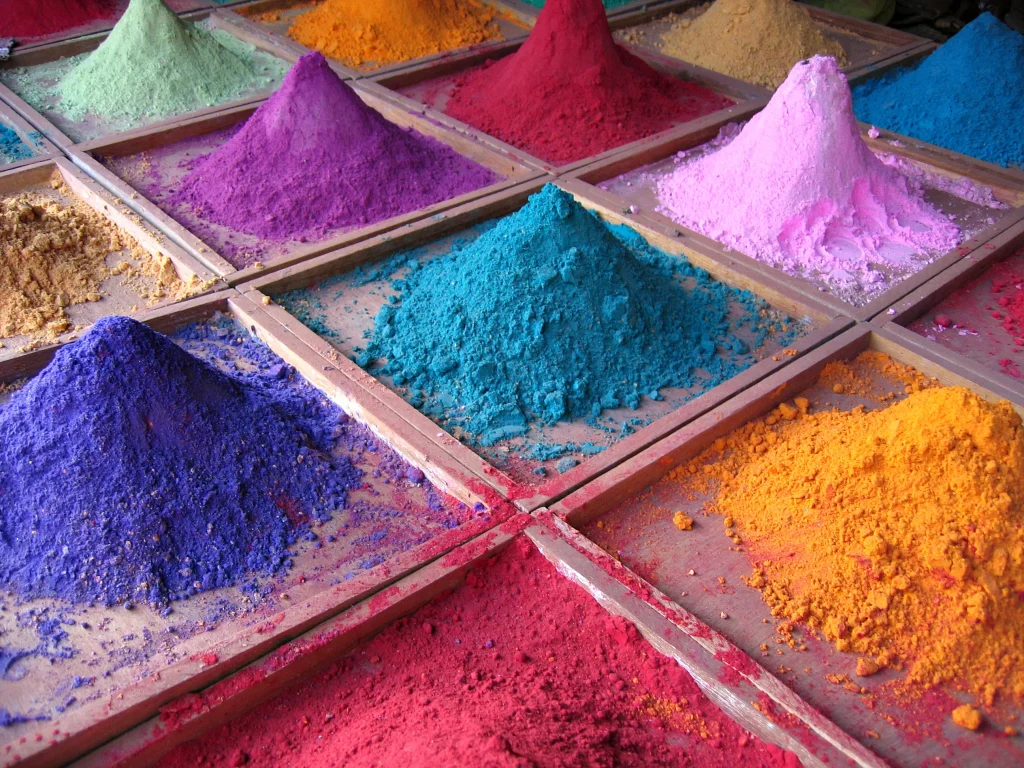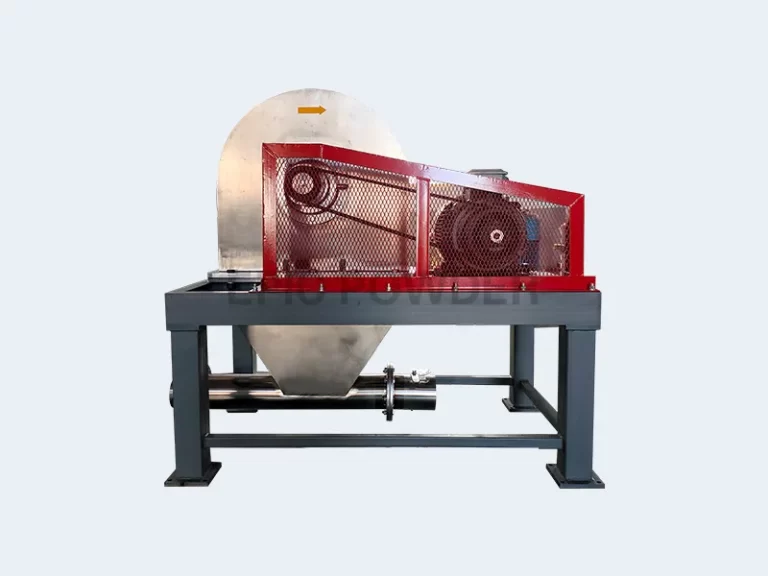Calcium carbonate is an inorganic compound with the chemical formula CaCO₃. It’s known for its abundant raw materials, simple production processes, and stable performance. These attributes make it widely used in various fields such as rubber, plastics, coatings, and inks. In the coatings sector, calcium carbonate serves as a filler and whitening agent, providing a skeletal structure. It is more affordable compared to latex and solvents. Its fine particles ensure even dispersion in coatings, increasing volume, reducing costs, and enhancing performance and texture. To achieve the desired fineness for these applications, calcium carbonate undergoes pulverization processes using equipment like ball mills, roller mills, and pin mills. These grinding methods help produce ultrafine powders essential for high-quality coatings. Additionally, coating machines are employed for surface modification. Ultrafine air classifiers ensure precise particle size distribution, optimizing the material’s compatibility and effectiveness in coatings.

Calcium Carbonate Applications in Powder Coatings
1. Calcium Carbonate for Latex Paint

In latex paints, calcium carbonate acts as an extender pigment, typically used at 10%-50% levels. It provides filling effects, resulting in a fine, uniform texture with high whiteness. It also offers dry hiding power, especially when using ultrafine products. When particle sizes approach those of titanium dioxide, it enhances hiding power, film strength, water resistance, drying speed, and scrub resistance.
For instance, ultrafine ground calcium carbonate significantly shortens dispersion and sanding times in latex paint production, improves hiding power, adjusts latex viscosity, reduces titanium dioxide usage, and enhances putty sanding performance. In paint formulation design, high-performance latex paints use ultrafine calcium carbonate, while lower-grade ones opt for coarser particles with low oil absorption. Currently, heavy calcium carbonate with d97 < 10μm, d50 around 1.5μm, whiteness >95%, and CaCO₃ ≥98% performs well in interior wall latex paints.
Producing such precise particle sizes often involves calcium carbonate pulverization with ball mills or roller mills, followed by classification using ultrafine air classifiers to ensure consistency.
2. Calcium Carbonate for Automotive Paint

Automotive underbody and wheel arch areas are frequently exposed to impacts from sand, gravel, and wastewater, which can damage coatings and lead to corrosion. To address this, underbody coatings with stone-chip resistance and anti-corrosion properties are applied.
PVC plastisol is one type of automotive chassis paint, primarily composed of PVC paste resin, plasticizers, fillers (calcium carbonate), stabilizers, tackifiers, solvents, and other additives. Calcium carbonate constitutes nearly 30% of the total (depending on the formula), and nano calcium carbonate improves rheological properties and impact resistance more than ordinary types.
Automotive chassis paints require low viscosity for easy spraying and good flow during application, but high viscosity post-application to prevent sagging. This thixotropic behavior is achieved with nano calcium carbonate, which offers high activation, yield stress, and thixotropy.
To manufacture nano-scale calcium carbonate, advanced pulverization equipment like pin mills and coating machines for surface treatment are essential, ensuring optimal performance in automotive coatings.
3. Calcium Carbonate for Inks

In printing inks, calcium carbonate mainly reduces costs and increases volume as a filler. High-performance ultrafine calcium carbonate is preferred, with particles between 0.02-1.0μm, high specific surface area, oil absorption, transparency, brightness, and stability.
In practice, nano light calcium carbonate or activated nano light calcium carbonate is ideal, though the latter’s higher price leads to more use of the former. Activated calcium carbonate yields inks with good body, viscosity, printing performance, fast drying, and no side effects. Its small particles provide excellent dispersion, transparency, gloss, hiding power, ink absorption, and drying, resulting in fine prints with complete dots. With resin binders now common in inks, activated calcium carbonate’s stability has largely replaced other fillers.
Domestic high-end ink fillers use ultrafine calcium carbonate that is activated, with spherical or cubic crystals. Pulverization via ball mills or roller mills, combined with ultrafine air classifiers, is key to achieving these specifications.
4. Calcium Carbonate for Powder Coatings

Fillers in powder coatings often contain heavy metals, failing international standards, especially for exports to Europe and the US where heavy metal limits are strict. Calcium carbonate, being inexpensive and free of heavy metals, can replace barium sulfate, ideal for coating toys, strollers, sports equipment, kitchenware, and appliances.
Applications include:
• As a filler for high-gloss coatings.
• In semi-gloss coatings, directly added without matting agents, saving costs.
• As a white inorganic pigment, used with titanium dioxide to reduce costs.
• Suitable for low-heavy-metal environmental products like children’s toys.
• Improves powdering rate and spray area, especially in hybrid powders.
Pin mill and coating machine technologies enhance surface properties, making calcium carbonate more effective in powder coatings.
Development Trends of Calcium Carbonate in the Coatings Industry
1. Nanonization
In the coatings industry, nano calcium carbonate provides steric hindrance, preventing settling while adding whiteness and gloss without affecting hiding power, improving storage stability. Its “blue shift” effect in latex shields against UV and thermal aging, enhancing insulation.
As a filler, it boosts flexibility, hardness, leveling, film deposition, and permeability. In exterior coatings, it imparts hydrophobicity, increasing crack resistance and stain resistance. In water-based latex paints, it reduces stress concentration from rigid particles, improving toughness via micro-cracks and elastic deformation.
Adding 2%-5% specially treated nano calcium carbonate to traditional latex paints enhances rheology, can-opening, water resistance, scrub resistance, and hardness exponentially. Companies like Japan’s Shiraishi and Italy’s Sim produce nano calcium carbonate for modifying water-based latex paints.
Due to nano effects, high surface area, activated atoms, and polymer interactions, it imparts special functions. Its thixotropy suits automotive chassis anti-stone-chip coatings and topcoats. Achieving nano sizes requires precise pulverization with ball mills, roller mills, or pin mills, and ultrafine air classifiers for separation.
2. Functionalization
As technology advances and living standards rise, consumers demand higher functionality, making high-performance, multifunctional coatings a trend. Adding nano calcium carbonate and nano ZnO provides antibacterial and anti-mold effects while improving weather resistance and overall quality.
Recently, domestic and international paint manufacturers and research institutions are exploring non-metallic minerals and deep-processed products to enhance or add new functions to coatings, becoming a hotspot in architectural coatings.
3. Surface Modification
Applying nano calcium carbonate to improve coatings is a hot topic, but direct use has drawbacks: high surface energy leads to agglomeration; hydrophilic and oleophobic surfaces hinder dispersion in organics, weakening bonds and causing defects.
Compatibility with base materials differs from polymers in plastics or rubber due to functional groups, molecular weight, polarity, and interactions. Thus, surface modification is essential for successful application, often using coating machines to enhance dispersion and performance.

4. Specialization
With calcium carbonate industry growth, specialized products for coatings have emerged: specific crystal forms, sub-0.1μm sizes, non-settling, high gloss, easy dispersion. High-end producers seek dedicated calcium carbonate.
Overall, with the increasing awareness of environmental protection, the demand for environmentally friendly fillers in the coating industry is growing, and calcium carbonate, as a natural and non-toxic filler, is also gaining attention.It improves performance and texture for high-end uses and lowers costs for large-scale production, promising sustained growth in coatings.
Epic Powder
For top equipment in calcium carbonate processing, including pulverization systems, ball mills, roller mills, pin mills, coating machines, and ultrafine air classifiers, consider Epic Powder Machinery, a leader in innovative powder technology solutions. Contact us today if you have further questions about our products.